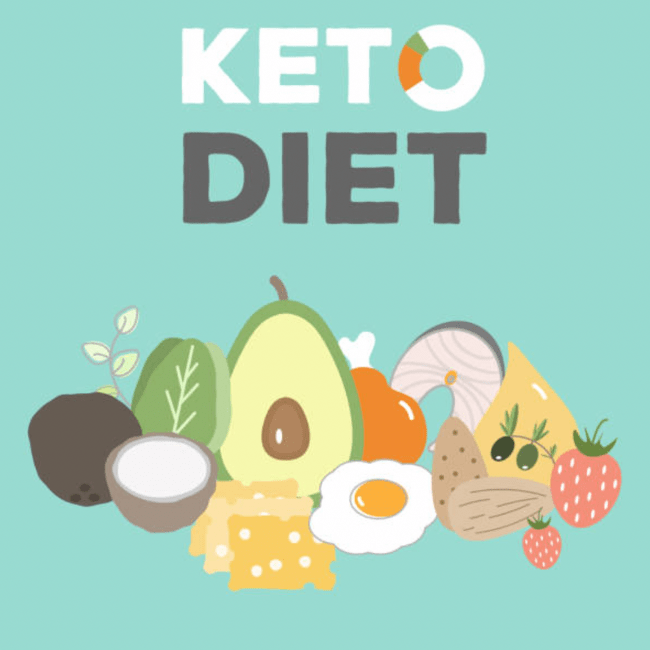Keto Diet: A Guide For Beginners

The ketogenic diet or for short, the keto diet, is a low-carb and high-fat diet that offers many health benefits. Many studies show that this type of diet can help you lose weight. There is also research that suggests diabetes, cancer, epilepsy, and Alzheimer’s disease.
Basically, the keto diet shares many similarities with the Atkins and low-carb diets. This, on the other hand, involves drastically reducing carbohydrate intake and replacing it with fat. This reduction in carbs, then, puts your body into a metabolic state called ketosis.
When this happens, your body becomes incredibly efficient at burning fat for energy. It also turns fat into ketones in the liver, which can supply energy for the brain. It causes significant reductions in blood sugar and insulin levels.

Keto Diet: A Guide For Beginners
Different versions of the keto diet
Standard ketogenic diet (SKD)
A very low carb, moderate protein, and high-fat diet. It also typically contains 70% fat, 20% protein, and only 10% carbs.
Cyclical ketogenic diet (CKD)
This also involves periods of higher-carb refeeds. This includes five ketogenic days before two high-carb days.
Targeted ketogenic diet (TKD)
This diet, on the other hand, allows you to add carbs around workouts.
High protein ketogenic diet
Similar to SKD, this includes more protein. The ratio is often 60% fat, 35% protein, and 5% carbs.
The keto diet can help in losing weight.
Research shows that the keto diet may be as effective for weight loss as a low-fat diet. This diet becomes so filling that you can lose weight without counting calories or tracking your food intake. The study follows a very low-carb keto diet can become slightly more effective for long-term weight loss than a low-fat diet. People who followed the keto diet have lost an average of two pounds more than the group who followed a low-fat diet.
Losing excess fat is closely linked to type 2 diabetes.
Diabetes is characterized by changes in metabolism, high blood sugar, and impaired insulin function. With the keto diet helping you lose excess fat, it can be closely linked to type 2 diabetes, prediabetes, and metabolic syndrome.
In one study, researchers proved that the keto diet improved insulin sensitivity. Women with type 2 diabetes followed a keto diet for ninety days and they found significantly reduced levels of hemoglobin A1C. It is a measure of long-term blood sugar management.
Other health benefits of the keto diet:
- Heart disease
- Cancer
- Alzheimer’s disease
- Epilepsy
- Parkinson’s disease
- Polycystic ovary syndrome
- Brain injuries
Foods to avoid on a keto diet:
- Sugary foods
- Grains or starches
- Beans or legumes
- Root vegetables
- Low fat or diet products
- Unhealthy fats
- Alcohol
- Sugar-free diet foods
Foods to eat on a keto diet:
- Meat
- Fatty fish
- Eggs
- Butter and cream
- Cheese
- Nuts and seeds
- Healthy oils
- Avocados
- Low-carb veggies
- Condiments

However, the keto diet also has its risks.
Wellness Dietitian Mary Condon, RN, LDN, pointed out that you should always consult a primary care doctor before starting this diet.
“If you are on diabetic medication that causes low blood sugar, those meds may need to be adjusted within a few days. There are heart-healthy sources of fat. However, if that person is not educated on heart-healthy sources of fat, they may consume excessive amounts of saturated fats that can increase your risk of heart disease.”
The keto diet could cause low blood pressure, kidney stones, constipation, nutrient deficiencies, and an increased risk of heart disease. As a strict diet, keto can also cause social isolation or disordered eating. This won’t be safe for those with any conditions involving their pancreas, liver, thyroid, or gallbladder.
There isn’t one diet that’s good for everyone. Do your research, consult a dietitian, discuss with your doctor, and make sure you’re safe.
Angela Grace P. Baltan has been writing professionally since 2017. She doesn’t hesitate to be opinionated in analyzing movies and television series. Aside from that, she has an affinity for writing anything under the sun. As a writer, she uses her articles to advocate for feminism, gender equality, the LGBTQIA+ community, and mental health among others.






